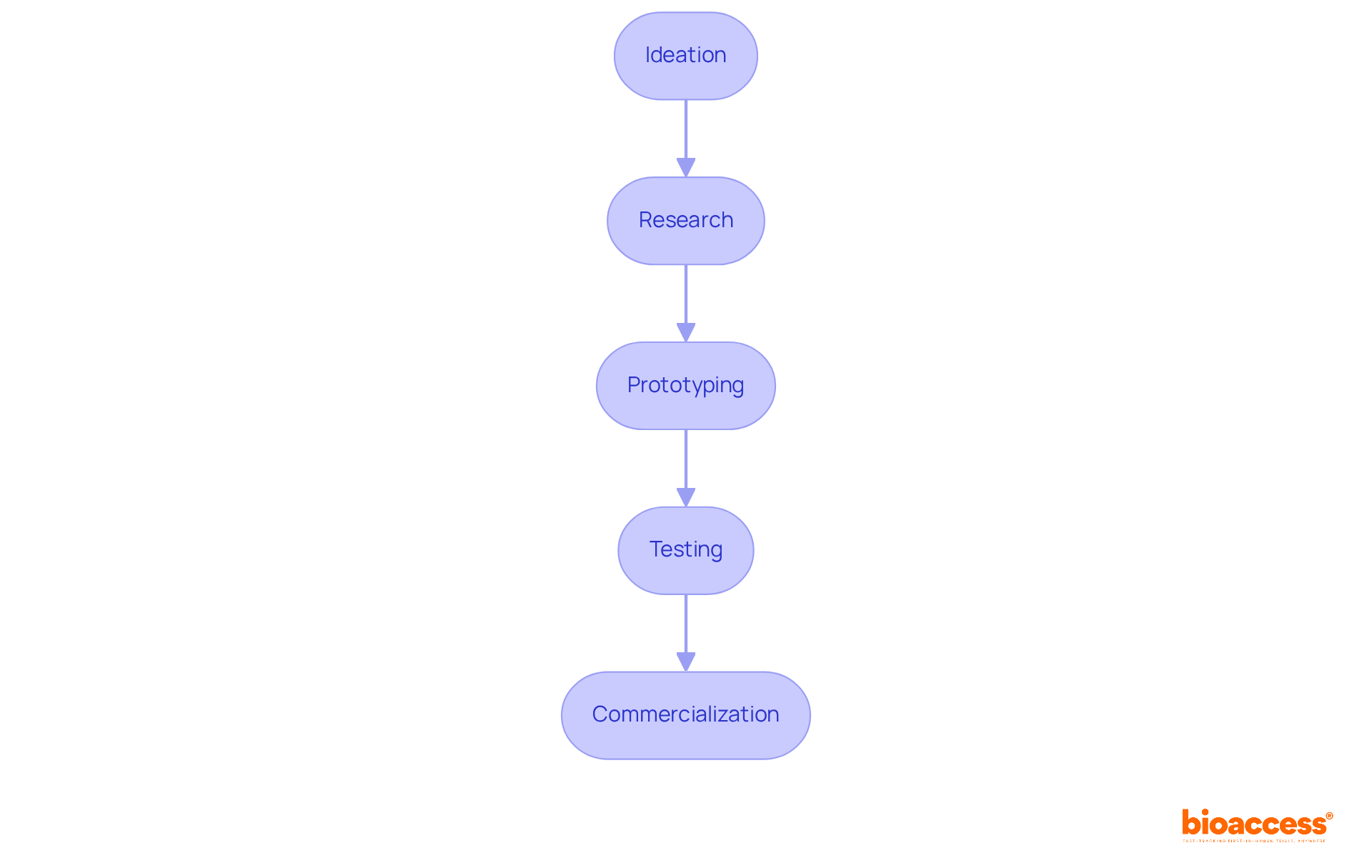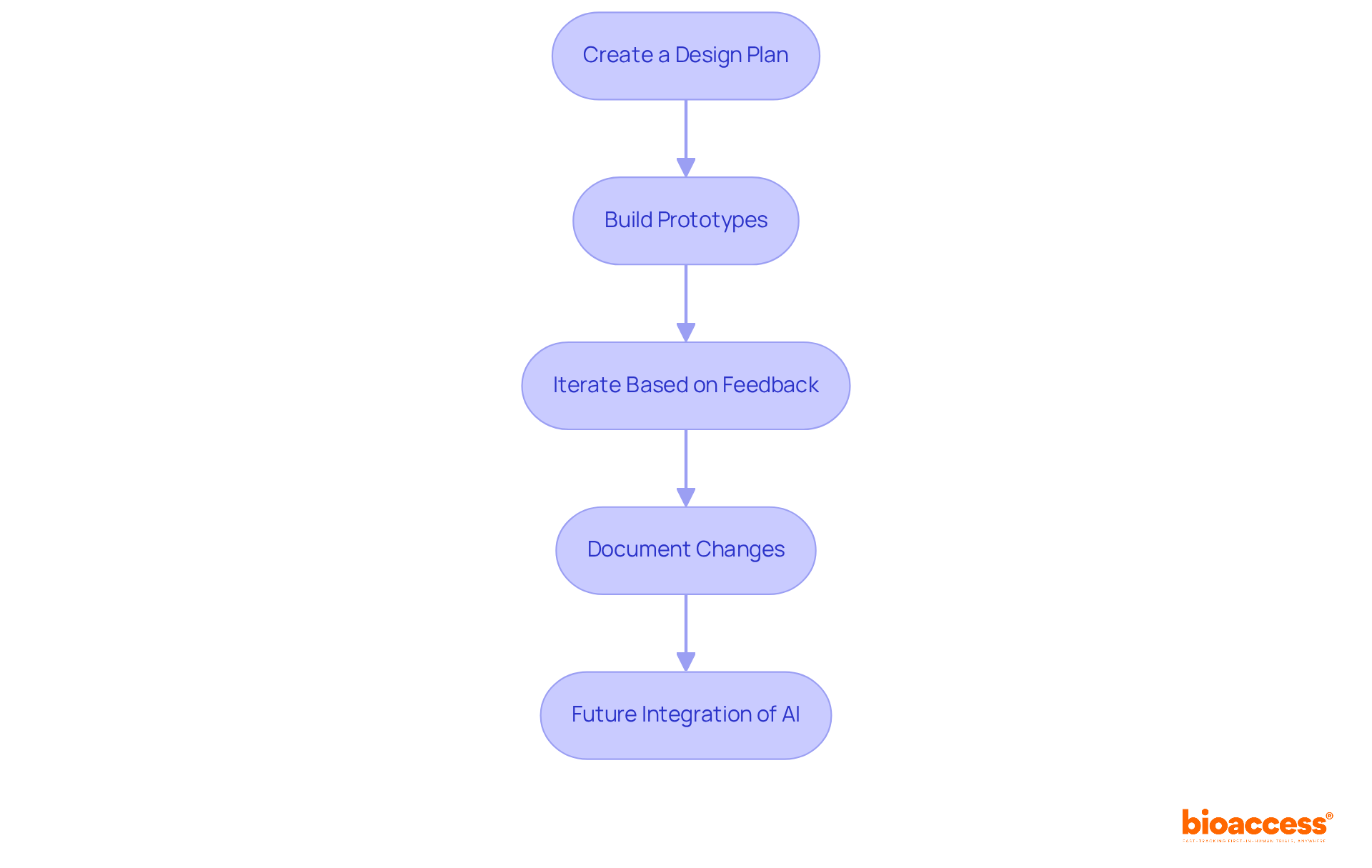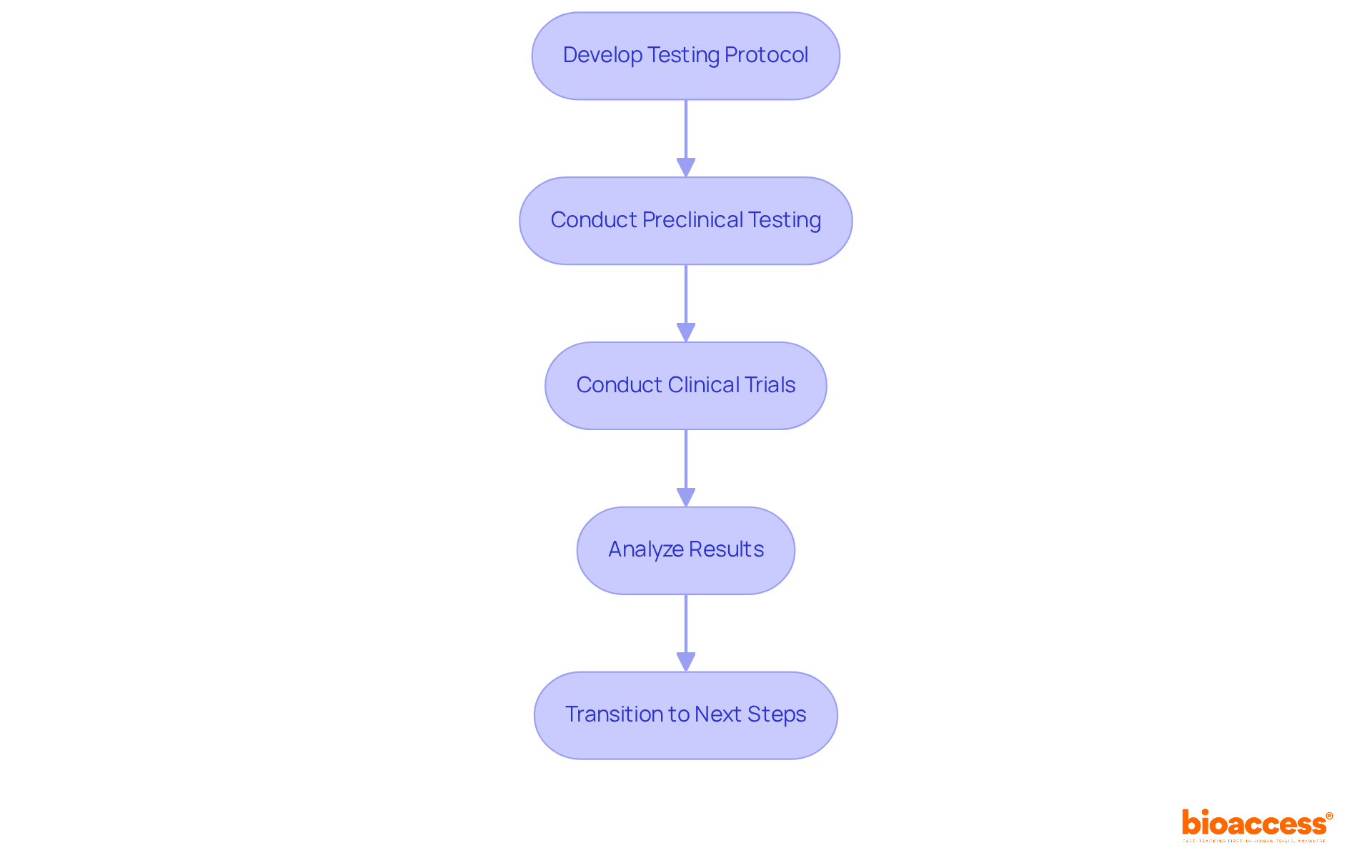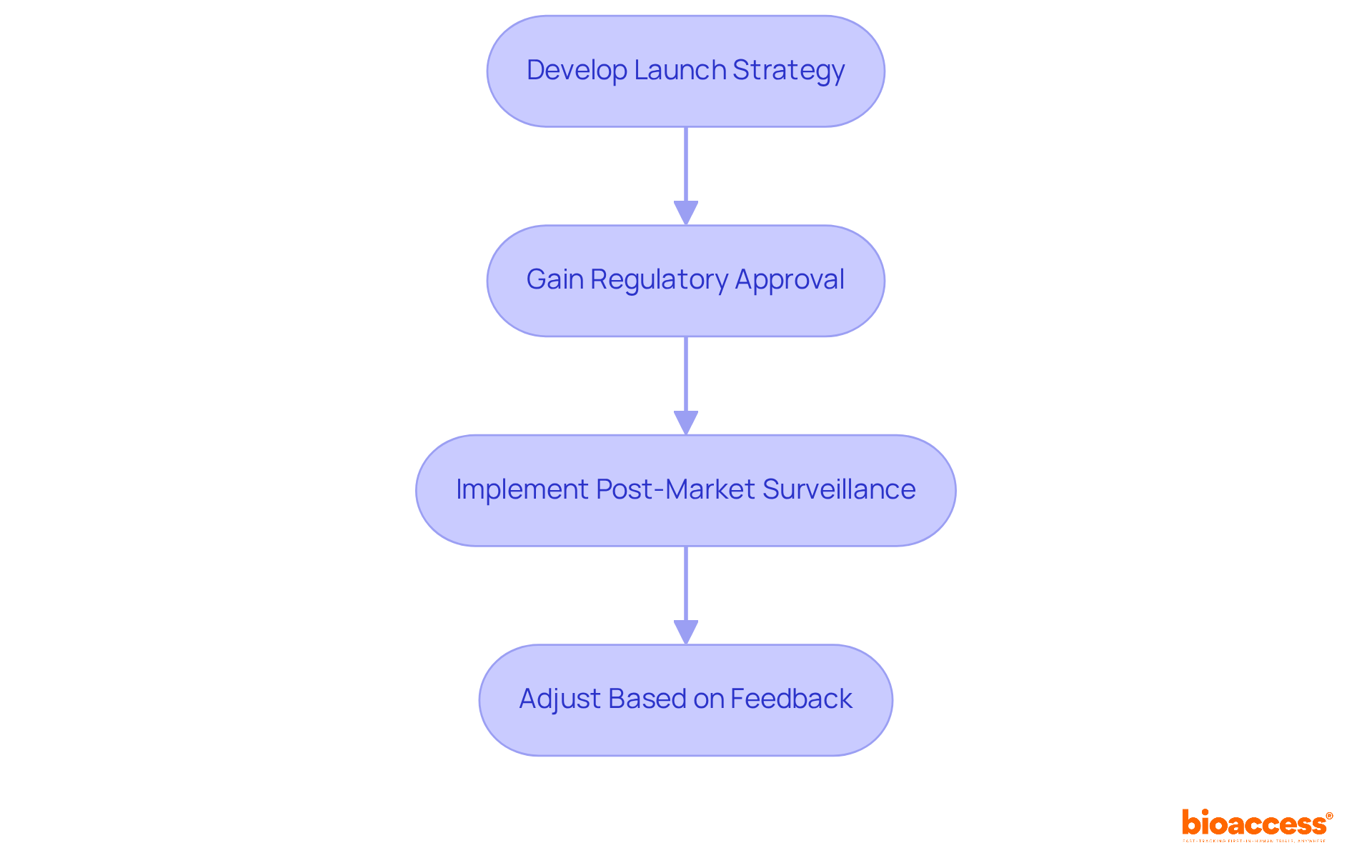


The article delineates a five-step process for mastering medical product development:
Each step is essential for ensuring that medical products comply with regulatory standards and address market needs. This underscores the significance of meticulous planning, active stakeholder engagement, and iterative feedback to bolster product relevance and safety. As the Medtech landscape evolves, understanding these steps becomes increasingly crucial for those involved in clinical research.
Navigating the intricate landscape of medical product development is no small feat; each phase presents its own set of challenges and opportunities. From the initial spark of ideation to the complexities of commercialization, understanding the entire process is crucial for innovators aiming to create impactful healthcare solutions. As the industry faces increasing pressure to bring products to market efficiently, developers must ensure they not only meet regulatory standards but also address real-world needs. This article outlines five essential steps that empower medical product developers to streamline their journey and enhance their chances of success.
The medical product development process encompasses several critical stages: ideation, research, prototyping, testing, and commercialization. Each stage demands meticulous planning and execution to ensure compliance with regulatory standards and alignment with market needs. Understanding these phases is essential for successful product development.
Ideation: This initial stage involves generating innovative ideas based on unmet clinical needs or advancements in technology, setting the foundation for the entire development process.
Research: Conducting comprehensive market research is vital to grasp the competitive landscape and regulatory requirements. This stage informs strategic decisions and helps identify potential challenges.
Prototyping: Developing initial prototypes allows teams to visualize and test concepts, crucial for refining ideas and ensuring they meet design specifications.
Testing: Rigorous testing validates the product's safety and efficacy. This phase is essential, as clinical trials represent roughly 69% of total R&D expenses, emphasizing the significance of comprehensive assessment before product launch. With bioaccess®'s accelerated medical device clinical study services, including Early-Feasibility Studies (EFS) and First-In-Human Studies (FIH), companies can navigate these challenges more effectively, achieving 50% faster patient enrollment and benefiting from FDA-ready data that results in significant cost savings of $25K per patient.
Commercialization: The final stage involves preparing for entry into commerce by crafting effective marketing strategies and securing necessary regulatory approvals. Successful commercialization is often influenced by the speed of regulatory processes, which can take anywhere from one to five years. Bioaccess®'s expertise in overseeing clinical trials and comprehending regulatory structures, including adherence to INVIMA, the Colombian National Food and Drug Surveillance Institute, simplifies the journey to commercialization.
In recent years, the typical duration to introduce a new medical device has been reported to range from three to seven years or longer, highlighting the necessity for efficient processes. Regulatory compliance is essential during these phases, ensuring that items not only fulfill consumer demands but also conform to safety standards. By mastering these phases, innovators can more effectively navigate the complexities of medical product development.

To effectively identify market needs in healthcare, it is imperative to follow these essential steps:
Conduct Market Research: Leverage surveys, focus groups, and interviews to gather valuable insights from potential users and stakeholders. Effective research in the industry can lead to enhanced patient outcomes and increased revenue for healthcare organizations.
Analyze Rivals: Investigate current offerings to identify gaps in the industry and opportunities for improvement. Understanding rival strategies and market trends is crucial for thriving in the competitive landscape of Medtech.
Define the Problem: Clearly articulate the specific issue your offering aims to address, ensuring it resonates with the target audience. This step is vital for aligning your offering with the actual needs of healthcare professionals and patients.
Engage Stakeholders: Collaborate with healthcare professionals, patients, and regulatory bodies, such as INVIMA, to validate your findings and enhance your concept. INVIMA plays an essential role in supervising medical devices in Colombia, ensuring adherence to health standards and facilitating the import and export of goods. Furthermore, bioaccess provides extensive clinical trial management services, such as feasibility studies, site selection, compliance reviews, and project management, which are crucial for informed innovation. Involving stakeholders guarantees that your development process is guided by real-world insights, improving its relevance and potential success.
By adhering to these steps, organizations can effectively navigate the complexities of market needs analysis in 2025, ensuring their medical product development meets the evolving demands of the healthcare sector while contributing to local economies through job creation and healthcare enhancement.

To effectively develop and prototype your medical solution, adhere to the following steps:
Create a Design Plan: Begin by outlining the specifications and features of your offering, ensuring alignment with user needs and regulatory requirements. This foundational step is crucial for guiding the entire progression process.
Build Prototypes: Utilize rapid prototyping techniques, such as 3D printing and CAD modeling, to create initial prototypes. These methods not only speed up the creation timeline but also enable the customization of patient-specific devices, enhancing overall product relevance.
Iterate Based on Feedback: Engage in user testing with your prototypes to gather valuable feedback. This iterative process is essential for refining your design, as insights from end-users can lead to significant improvements in functionality and usability.
Document Changes: Maintain comprehensive records of design iterations and testing outcomes. This documentation is crucial for ensuring adherence to regulatory standards and will promote smoother future project phases.
In 2025, the integration of AI and machine learning in rapid prototyping is expected to streamline design processes and enhance predictive capabilities, further improving the efficiency of medical product development. As indicated by industry specialists, utilizing user feedback is crucial in medical product development to develop successful offerings that satisfy market needs and enhance patient outcomes.

To effectively test and validate your medical product, it is crucial to follow these essential steps:
Develop a Testing Protocol: Formulate a comprehensive plan detailing the types of tests to be conducted, including safety, efficacy, and usability assessments. This protocol serves as the foundation for all subsequent testing stages.
Conduct Preclinical Testing: Engage in rigorous laboratory evaluations to assess the item's performance and safety prior to human trials. Preclinical testing is vital, as it not only confirms the concept but also uncovers potential problems that could arise during clinical stages. Successful preclinical testing significantly enhances the likelihood of success in later stages, with small molecules achieving a 63% success rate compared to 79% for large molecules in this phase.
Conduct Clinical Trials: If relevant, advance to clinical trials to collect data on the item's effectiveness and safety in real-world environments. For instance, ReGelTec, Inc. successfully treated eleven patients with chronic low back pain using their HYDRAFIL™ solution in an Early Feasibility Study conducted in Colombia. This underscores the importance of robust clinical trials in the medical product development process for validating medical devices. Current statistics indicate that approximately 90% of clinical drug development efforts fail, emphasizing the necessity of thorough preclinical validation to mitigate risks during this phase.
Analyze Results: Thoroughly review the testing data to identify any issues and implement necessary modifications to the design. This iterative process is essential for ensuring that the final outcome meets regulatory standards and fulfills market needs.
Transition to Next Steps: After analyzing the results, prepare to move into the next stages of development, ensuring that all insights gained from testing inform future strategies and regulatory submissions.

To successfully launch your product and monitor its performance, follow these essential steps:
Develop a Launch Strategy: Begin by creating a comprehensive marketing and distribution plan that targets your identified audience. This strategy should leverage insights from successful case studies, including the application of Change Point Analysis (CPA) to enhance post-market surveillance. Such methods have proven effective in detecting temporal patterns and improving safety, underscoring the importance of a well-thought-out launch strategy.
Gain Regulatory Approval: It is crucial to ensure that all required authorizations are secured before your product enters circulation. The regulatory approval process for medical product development in 2025 highlights the necessity for thorough documentation and compliance with evolving standards. Understanding the intricacies of this process—including the feasibility and selection of research locations, lead investigators, compliance evaluations, and trial preparation—can significantly influence the time to market and overall success of medical product development.
Implement Post-Market Surveillance: Establish a robust system for monitoring your product's performance and safety once it is in use. This includes collecting user feedback, analyzing adverse event reports, and adhering to current trends in post-market surveillance. Notably, healthcare companies have an average Net Promoter Score (NPS) of 25.6, emphasizing the critical role of effective post-market monitoring in enhancing user satisfaction. Such monitoring not only ensures compliance but also boosts safety and user satisfaction.
Adjust Based on Feedback: Be prepared to make iterative enhancements to your offering based on real-world usage and input from healthcare professionals and patients. As Ian Hale, Vice President of Commercial Content at Veeva, asserts, "When your commercial content is reaching consumers twice as fast as your competition, your new product gains traction." This adaptive approach is vital for maintaining relevance in a competitive market, ultimately leading to increased user retention and satisfaction.

Mastering the medical product development process is essential for innovators aiming to bring effective solutions to the healthcare market. By understanding the critical stages—ideation, research, prototyping, testing, and commercialization—developers can create products that meet both regulatory standards and market demands. Each phase plays a pivotal role in ensuring that the final product is not only safe and effective but also aligns with the needs of healthcare professionals and patients alike.
Throughout this article, key strategies for navigating this complex landscape have been highlighted. Conducting thorough market research to identify unmet needs, employing rapid prototyping techniques, and engaging stakeholders are crucial steps for refining ideas and ensuring relevance. Testing and validation are emphasized as integral components, underscoring the necessity of rigorous assessments to mitigate risks and enhance the likelihood of success. A well-planned launch strategy and robust post-market monitoring are vital for sustaining product performance and user satisfaction.
In conclusion, the landscape of medical product development is both challenging and rewarding. By adopting best practices and leveraging innovative technologies, organizations can streamline their processes and contribute significantly to improving patient outcomes. The call to action is clear: embrace these strategies and commit to excellence in every stage of development, ensuring that the next wave of medical advancements is both impactful and safe for all users.
What are the main stages of the medical product development process?
The main stages of the medical product development process are ideation, research, prototyping, testing, and commercialization.
What is the purpose of the ideation stage in medical product development?
The ideation stage involves generating innovative ideas based on unmet clinical needs or advancements in technology, setting the foundation for the entire development process.
Why is market research important in the medical product development process?
Conducting comprehensive market research is vital to understand the competitive landscape and regulatory requirements, which informs strategic decisions and helps identify potential challenges.
What role does prototyping play in medical product development?
Prototyping allows teams to visualize and test concepts, which is crucial for refining ideas and ensuring they meet design specifications.
How significant is the testing phase in the medical product development process?
The testing phase is essential for validating the product's safety and efficacy, with clinical trials representing roughly 69% of total R&D expenses, highlighting the need for comprehensive assessment before product launch.
What services does bioaccess® provide to assist with clinical trials?
Bioaccess® offers accelerated medical device clinical study services, including Early-Feasibility Studies (EFS) and First-In-Human Studies (FIH), helping companies achieve faster patient enrollment and obtain FDA-ready data.
What is involved in the commercialization stage of medical product development?
The commercialization stage involves preparing for market entry by crafting effective marketing strategies and securing necessary regulatory approvals, influenced by the speed of regulatory processes.
How long does it typically take to introduce a new medical device to the market?
The typical duration to introduce a new medical device has been reported to range from three to seven years or longer.
What steps should be taken to identify market needs in healthcare?
Essential steps include conducting market research, analyzing rivals, defining the problem, and engaging stakeholders to validate findings and enhance concepts.
What is the role of INVIMA in the medical product development process in Colombia?
INVIMA supervises medical devices in Colombia, ensuring adherence to health standards and facilitating the import and export of goods, playing a critical role in regulatory compliance.
How can organizations contribute to local economies through medical product development?
By effectively navigating market needs analysis and developing relevant medical products, organizations can contribute to job creation and enhance healthcare in local economies.